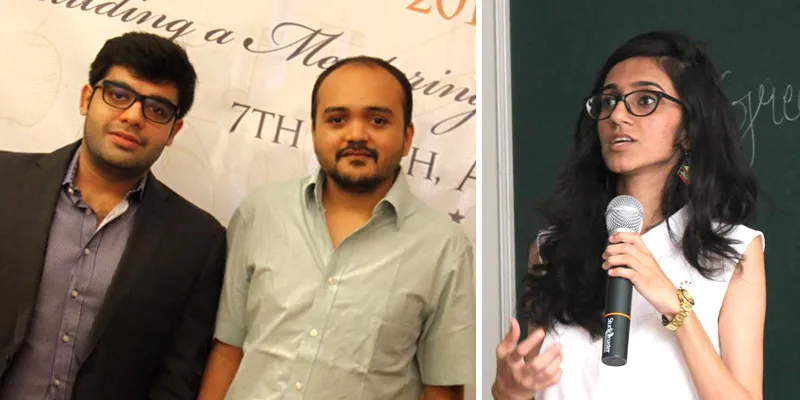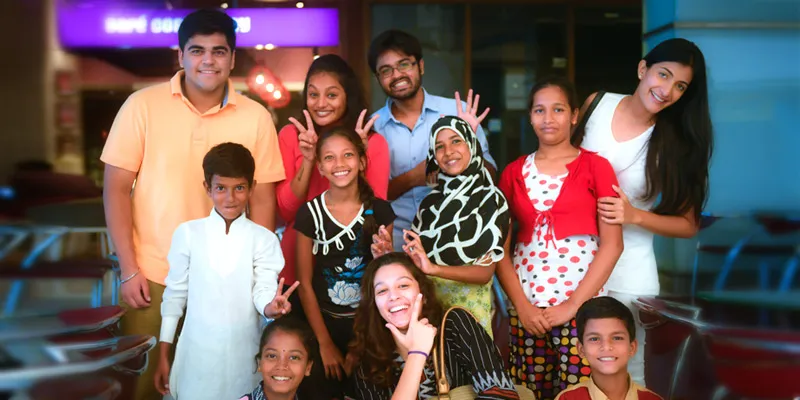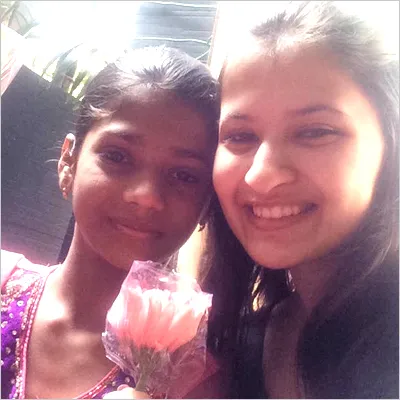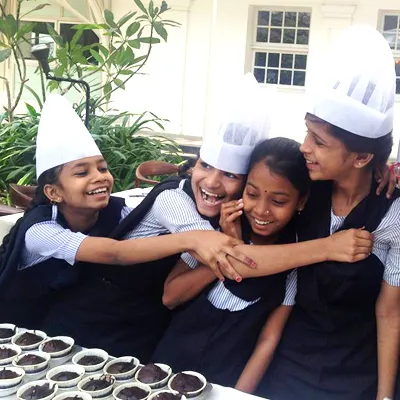How the Green Batti Project lights up the lives of slum dwellers in Mumbai
Green denotes success, prosperity, flourishing farms and economies. However, for the under resourced communities of India living in fragile shanties and huts, in pockets where the sun doesn’t shine in otherwise thriving cities, the colour would perhaps signify nothing more than jealousy, envy, and a constant reminder of everything they can’t have. That’s about to change – it shall now symbolise optimism, a new hope, with The Green Batti Project.

How The Green Batti went off in Samyak’s head
About two years ago, even before The Green Batti Project came about, Samyak Chakrabarty, one of its founders, had adopted a Marathi medium primary school in Dharavi on its way to closure due to lack of funds.
“This gave me an insight into the lives of children from under-resourced communities. Apart from a good quality formal education they lacked positive adult influences due to difficult domestic circumstances. Simply put, they don’t have anyone to inspire, motivate, and guide them on their way forward.
That’s how the idea struck me – to pair such children with someone who can be that positive adult role model and arm them with the required self-confidence, soft skills, and direction to be able to potentially break free from their prevailing socioeconomic conditions.”
Along with Co-founders Aakansha Kedia and Deep Master, he built The Green Batti Project, India’s largest one-on-one mentorship program, pairing young professionals with teenagers and the youth from under-resourced communities.
With the class system so deeply entrenched into the ethos of our country, the lesser privileged communities start their lives with their wings cut off, owing simply to the class they’re born into. Their formal education itself lacks the necessary depth and thoroughness – so, training in professional skills is out of question. Moreover, the odds are that most of these children are braving very tempestuous circumstances at their homes to be able to experience the enriching educational and co-curricular journey every child deserves. The Green Batti Project is their ticket to reach for more. By granting them access to talented professionals, they obtain raw and unbridled exposure to the story and lessons every young and successful person has to share.
“The idea is to bridge the educational inequity that exists in our country as well as the imbalance of opportunity and experience – by enabling a transfer of life skills, social skills, and financial literacy and provide essential exposure to technology, to be able to successfully break free from their prevailing socioeconomic situations.”

How easy it is to join in and do your bit
Their macro level aim is to enable a culture of sustained volunteering in India. People often think giving back is either criminal on the pocket or that it is too complicated and time consuming and will end up being a burden. The Green Batti wants to change this mindset.
They have built a pool of competent mentors who meet the simple criteria of being aged between 21 and 35 years, students studying in post-graduate programs, or professionals who have six months of experience in their fields. Their mentees are all between 11 and 15 years old, who are at present studying with Teach For India, or Mumbai Smiles.
The set up of their program is highly organised, regular, and easy to make space for in your weekly planners.
The sessions take place once a week for two hours at the mutual convenience of the mentor–mentee duo. After the mentor picks up his assigned mentee from their home, they head to a coffee shop within an eight km radius to chat about everything under the sun. There is also an SMS based check-in and check-out feature on their web-based program management system to ensure safety of the pair.
At present, they have a 1000 strong mentor–mentee community and by the end of next year they aim to touch the 5000 mark.
“Speak to any of our mentors they’ll tell you how easy, fun and engaging we’ve designed our structure to be,” challenges Samyak.

When the mentors met the mentees
And indeed, the mentors vouch for it too. “I read about The Green Batti Project on social media. The uniqueness of the program and the ability to make a difference in a child’s life in a non-monetary manner is what interested me the most,” says Neha Mathur, who is a full time mentor with the program.
As mentioned above, an entity associated with The Green Batti Project is a school mentored under the Teach For India program, who sought The Green Batti Project for their patrons’ “outside the classroom education.” Karan Mehta, a Teach For India fellow explains how his entire classroom eagerly looks forward to their mentor–mentee sessions, and how he’s seen some of the most remarkable changes in students he was starting to give up on.
“One child in my classroom – your textbook troublemaker – was getting more and more difficult to handle. After a few months of sessions, he came back to class all quiet, obedient, and civil. He tells me – to my absolute shock – that he has learnt how elders must be respected.”
“Another girl, Firdous, on the contrary – I had no idea what she sounded like for a whole year! Some sessions later, now, her hand shoots up for almost everything – whether it is to give an answer or to ask me to explain something once again. She has become a confident little girl!”
I had to hear what goes down in these sessions myself, so I got in touch with Neha’s bright little mentee called Sharmin.
“Kaise ho?” I ask her.
“I’m fine, thank you. How are you, ma’am?” she replies, without so much as a waver in her tone. In a subtle yet authoritative manner she establishes her newfound ability to conduct a conversation with anyone like an equal.
I continue in English asking her what she loves the most about her meetings with her mentor. “I love learning English from her. She’s very good at it and I want to talk and sound just like her. She teaches me all these new words and phrases that I don’t have in my textbook. Aren’t you surprised out of your wits?” cracking a smile at the phrase she had just managed to use appropriately!
Above everything else, these sessions conjure a special bond that creates some great memories for the two. “I remember the first time I met her, she had got me a beautiful pink daisy and she told me ‘Didi, pink is my favourite colour’. She also made me the sweetest Valentine’s Day card!” recalls Neha.
“The greatest change I saw was when we recently got featured on Humans of Bombay. Ever since then I see a huge boost in her confidence, she speaks her mind more freely now,” says an emotional Neha.
The exchange of ideas and perspectives is symbiotic and the mentees have a lot to offer – in their innocence, inquisitiveness, and earnestness.
“I think she has altered my perspective in more ways than one. She comes from a background with limited access to even the bare necessities of life, yet, I have never seen her be unhappy about anything apart from her mother’s health. It made me realise how much me and many others like me take for granted when I learnt that she wakes up early in the morning to fill water for the whole family, helps her mother cook and look after the house, takes care of her baby sister, goes to school and finishes home work. And she’s only 13!” says the proud mentor.
A proud and content Samyak lives for moments like these. He recalls another incident that touched his heart. “Once at a bar, I saw a group of people continuously staring and smiling at me. Later, one of them approached me and said they all are mentors and celebrating their experiences with their mentees!” exclaims Samyak.

How the best intentions can be monetised
Like many other NGOs who have found ways to become for-profit organisations and monetise their goodwill, TGBP has also structured a solid revenue model to ensure constant growth and sustenance, having to never compromise on their offerances due to monetary shortcomings. As an initiative of Social Quotient, a fully for-profit social enterprise, all their volunteers are fully paid employees.
Their costs are primarily operational. For example, the entire program is managed by a high-tech web-based application to monitor safety and impact. The idea of their parent organization – Social Quotient is to enable consumer brands to leverage social causes as a marketing and brand engagement platform. This is how they make their money.
“We look at social causes as an intellectual property – similar to how say a percept looks at Sunburn. We believe that just as music festivals and social media campaigns – social causes are a powerful way to build communities and offer sustained eyeballs as well as high brand recall. Thus, we create ways for consumer brands to see value in partnering with us in a way that does not affect the fundamentals of the cause.”
For example, financial literacy is a core impact area of the mentoring curriculum. Therefore, a banking brand has come on board as one of our partners.
If you don’t believe his claims, let the numbers do the talking. Turnover across six cities is nearly Rs 1.8 to two crore, with the potential to create more branding and therefore revenue opportunities as they expand.
Where you will see The Green Batti next?
Indeed, aggressive expansion is on the cards, and just like they were able to grow from 30 pairs to a 1000 in such a short time span, they intend to pull an encore of that pace and now expand to six cities. Another exciting aspect is the e-mentoring platform, to provide mentors to youth in areas like Kashmir, North East, and other tier 2 and tier 3 towns.”
An addition to their programs is their collaboration with new-age music producer Sanaya Ardeshir (Sand Dunes) to develop a program to mentor girls using music – to bring out creativity and self-expression.







